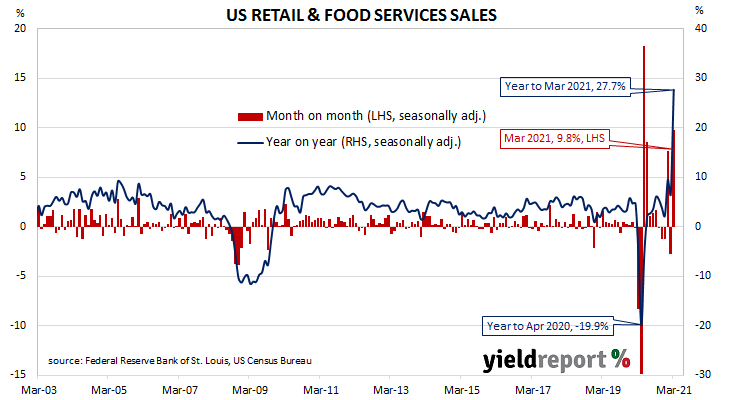Summary: US retail sales jumps in March; rise significantly larger than expected figure; stimulus payments, plus multiple other factors behind strength; rises in all retail categories; “vehicles and parts” the largest influence.
US retail sales had been trending up since late 2015 but, commencing in late 2018, a series of weak or negative monthly results led to a drop-off in the annual growth rate below 2.0% by the end of that year. Growth rates then increased in trend terms through 2019 and into early 2020 until pandemic restrictions sent it into negative territory. A “v-shaped” recovery then took place which was followed by some short-term spikes as federal stimulus payments hit households.
According to the latest “advance” sales numbers released by the US Census Bureau, total retail sales jumped by 9.8% in March. The rise was noticeably higher than the 5.0% increase which had been generally expected and it contrasted with February’s 2.7% fall after it was revised up from -3.0%. On an annual basis, the growth rate increased from February’s revised figure of 6.7% to 27.7% as the pandemic-induced reduction in spending from March 2020 temporarily raised annual growth rates.
“Strength in spending was broad-based, supported by the USD$1,400 stimulus cheques to an estimated 85% of American adults, an already-high savings rate, a rapidly improving labour market, successful vaccination program and rebound from weather-related weakness in February,” said ANZ economist Kishti Sen.

The report was released on the same day as February’s industrial production numbers and, despite the solid figures, longer-term US Treasury bond yields moved noticeably lower. By the end of the day, the 10-year Treasury yield had lost 5bps to 1.58% and the 30-year yield had shed 4bps to 2.28%. The 2-year yield remained unchanged at 0.15%.
All categories recorded higher sales over the month. The “Motor vehicle & parts dealers” segment provided the largest single influence on the overall result, rising by 15.1% for the month and by 71.1% for the year. Several other segments also made larger-than-normal contributions to the out-sized result.

